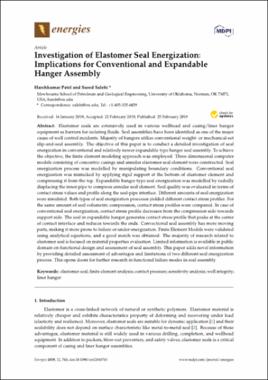| dc.contributor.author | Patel, Harshkumar | |
| dc.contributor.author | Salehi, Saeed | |
| dc.date.accessioned | 2019-04-01T17:01:54Z | |
| dc.date.available | 2019-04-01T17:01:54Z | |
| dc.date.issued | 2019-02-25 | |
| dc.identifier.citation | Patel, H.; Salehi, S. Investigation of Elastomer Seal Energization: Implications for Conventional and Expandable Hanger Assembly. Energies 2019, 12, 763. | en_US |
| dc.identifier.uri | https://hdl.handle.net/11244/317825 | |
| dc.description.abstract | Elastomer seals are extensively used in various wellhead and casing/liner hanger equipment as barriers for isolating fluids. Seal assemblies have been identified as one of the major cause of well control incidents. Majority of hangers utilize conventional weight- or mechanical-set slip-and-seal assembly. The objective of this paper is to conduct a detailed investigation of seal energization in conventional and relatively newer expandable type hanger seal assembly. To achieve the objective, the finite element modeling approach was employed. Three dimensional computer models consisting of concentric casings and annular elastomer seal element were constructed. Seal energization process was modelled by manipulating boundary conditions. Conventional seal energization was mimicked by applying rigid support at the bottom of elastomer element and compressing it from the top. Expandable hanger type seal energization was modelled by radially displacing the inner pipe to compress annular seal element. Seal quality was evaluated in terms of contact stress values and profile along the seal-pipe interface. Different amounts of seal energization were simulated. Both types of seal energization processes yielded different contact stress profiles. For the same amount of seal volumetric compression, contact stress profiles were compared. In case of conventional seal energization, contact stress profile decreases from the compression side towards support side. The seal in expandable hanger generates contact stress profile that peaks at the center of contact interface and reduces towards the ends. Convectional seal assembly has more moving parts, making it more prone to failure or under-energization. Finite Element Models were validated using analytical equations, and a good match was obtained. The majority of research related to elastomer seal is focused on material properties evaluation. Limited information is available in public domain on functional design and assessment of seal assembly. This paper adds novel information by providing detailed assessment of advantages and limitations of two different seal energization process. This opens doors for further research in functional failure modes in seal assembly. | en_US |
| dc.description.sponsorship | Funding: Work was partially funded by Bureau of Safety and Environmental Enforcement (Project No:
E17PC00005).
Open access fees fees for this article provided whole or in part by OU Libraries Open Access Fund.
Acknowledgments: The authors would like to extend their sincere gratitude to the University of Oklahoma for
providing necessary resources and granting the permission to publish this work. | en_US |
| dc.language | en_US | en_US |
| dc.rights | Attribution 4.0 International | * |
| dc.rights.uri | https://creativecommons.org/licenses/by/4.0/ | * |
| dc.subject | elastomer seal | en_US |
| dc.subject | finite element analysis | en_US |
| dc.subject | contact pressure | en_US |
| dc.subject | sensitivity analysis | en_US |
| dc.subject | well integrity | en_US |
| dc.subject | liner hanger | en_US |
| dc.title | Investigation of Elastomer Seal Energization: Implications for Conventional and Expandable Hanger Assembly | en_US |
| dc.type | Article | en_US |
| dc.description.peerreview | Yes | en_US |
| dc.identifier.doi | 10.3390/en12040763 | en_US |
| ou.group | Mewbourne College of Earth and Energy::Mewbourne School of Petroleum and Geological Engineering | en_US |

